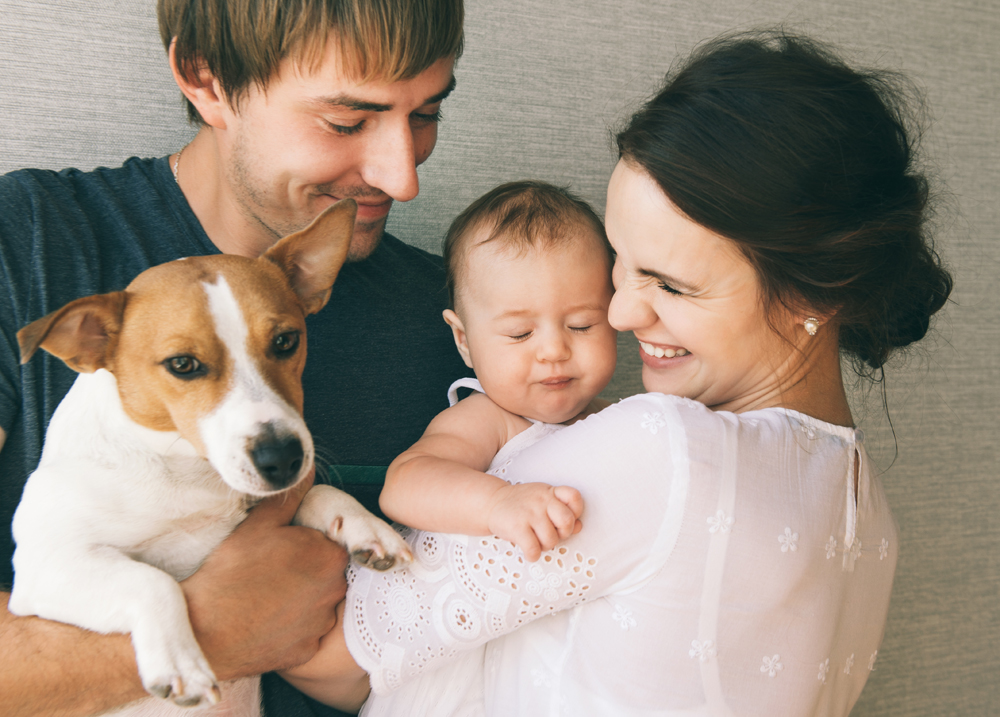How to prepare your dog for a new baby
There’s so much to think about when you’re getting ready for a baby, but if you have a dog it’s worthwhile preparing early to ensure a safe and happy start to the relationship between your pet and your new baby.
Solve existing behavioural issues
Finding the time to do behavioural training might be difficult after baby comes, as you won’t want to be dealing with tough behaviour issues with your dog while also trying to look after a new baby. Behaviour that seems harmless now, such as your dog jumping up on you, may become dangerous if you are heavily pregnant or holding a brand new baby in your arms. If your dog has serious behaviour issues such as aggression, you may need to consult a professional dog behaviourist to help solve these issues before the arrival of your new baby.
Safe Walks
Ensure your dog walks well on a lead, without pulling, tugging you or lunging unexpectedly. This will make it easier for you to keep taking your dog out on walks if you have a pram to manage as well. So, why not try some practice walks with the pram before baby arrives, to help your dog get used to it.
Socialise
Begin socialising your dog with babies and young children, and rewarding it for any positive interactions with them. If your dog hasn’t been socialised with children much, you will need to be very cautious when you get started and keep your dog on a lead. You may also need to put a muzzle on your dog if necessary.
Baby Sounds
Desensitise your dog to baby noises beforehand so they are unfazed by the real thing when it comes along. Play recordings of babies crying, laughing and screaming to your dog on a regular basis at all times of the day. Start at a low volume, then increase the volume slowly in small increments only when your dog is acting calmly and not stressed. Reward your dog for calm behaviour while these sounds play.
Baby's sleeping space
It is important that you make the nursery off-limits to your dog. Through careful and consistent training, you should be able to condition your dog into understand this is a place they are not allowed go without you. Once your dog understands the rules, you can let them to enter the room. But, it is important to maintain enough control to send your dog out of the room when you need to. If you find it difficult to maintain this flexibility then it’s best to keep it fully off limits.
Introducing your dog to baby
To encourage a safe and peaceful introduction, try these tips:
- Have someone bring home something that smells of your baby (such as a wrap it has been wearing), so your dog can become familiar with the scent before meeting her.
- Help your dog relax by ensuring it’s taken for a long walk and has used up some energy before the introduction.
- On arriving home from hospital, greet your dog first before introducing the baby. Remember, your dog will have missed you and will be excited to see you, so doing this will help create a calm environment.
- Make sure your dog is calm before it is allowed to come near the baby. While holding your baby, gently call your dog over and allow it to sniff baby. If there is more than one dog in the household, do this with only one dog at a time.
- Reward your dog for its calm behaviour when meeting the baby. You should do this for their first few interactions to help build a positive association.
Warning signs
Learn to read your dog’s body language for any indication that it’s not happy or comfortable in a situation. If your dog growls, has its hackles raised or bares its teeth remove the child from the situation immediately. If your dog is stressed out or fearful, this is also a warning sign. Look for things such as panting, tense body language, the dog’s tail between its legs, trembling, or the dog trying to hide or escape a situation. Pay attention to these signs and remove the child if you ever see any of them.
Finally, it is important to remember that you must always supervise all interactions between a dog and a baby or young child. Even if your dog is extremely friendly and docile, babies and young children can do unexpected things and any dog can react in a negative way if it feels scared or threatened.
If your dog gives any indication that it is frightened of or aggressive to a child, immediately separate the two and consult a qualified animal behaviourist to help resolve any issues your dog may have with the situation.

